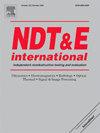太赫兹和超声信号反褶积重建地层研究进展
IF 4.5
2区 材料科学
Q1 MATERIALS SCIENCE, CHARACTERIZATION & TESTING
引用次数: 0
摘要
非破坏性评估技术,如太赫兹和超声波测试,使用短脉冲探测层状材料,并通过分析内部界面回波之间的时间延迟来重建其地层。然而,当地层足够薄时,连续的回波在时间上重叠,使得直接识别它们的数量和时间变得困难。在这种情况下,采用反褶积技术提取脉冲响应或回波位置和振幅等关键特征,提高局部地层的分辨率。本文回顾了四种广泛使用的反褶积算法,在稀疏脉冲响应的假设下进行地层重建,其中层边界被建模为离散的,尖锐的回声。讨论了两种时域方法——正交匹配追踪和基于1范数的稀疏反卷积,以及两种频域方法——多信号分类和自回归谱外推。他们的理论基础,实际实施和比较性能评估使用合成信号和实验回波图从太赫兹脉冲成像和超声。这些技术增强了区分紧密间隔界面的能力,适用于材料缺陷检测、医学诊断中的组织层分析以及3D成像的预处理。本文章由计算机程序翻译,如有差异,请以英文原文为准。
Stratigraphic reconstruction from terahertz and ultrasonic signals by deconvolution: A review
Nondestructive evaluation techniques, such as terahertz and ultrasonic testing, use short pulses to probe layered materials and reconstruct their stratigraphy by analyzing time delays between echoes at internal interfaces. However, when layers are sufficiently thin, successive echoes temporally overlap, making direct identification of their number and timing challenging. In such cases, deconvolution techniques are employed to extract the impulse response or key features such as echo locations and amplitudes, improving resolution of the local stratigraphy. This review examines four widely used deconvolution algorithms for stratigraphic reconstruction under the assumption of a sparse impulse response, where layer boundaries are modeled as discrete, sharp echoes. Two time-domain methods—orthogonal matching pursuit and -norm-based sparse deconvolution—and two frequency-domain approaches—multiple signal classification and autoregressive spectral extrapolation—are discussed. Their theoretical foundations, practical implementation, and comparative performance are evaluated using synthetic signals and experimental echograms from terahertz pulsed imaging and ultrasound sonography. These techniques enhance the ability to distinguish closely spaced interfaces and are applicable to defect detection in materials, tissue-layer analysis in medical diagnostics, and preprocessing for 3D imaging.
求助全文
通过发布文献求助,成功后即可免费获取论文全文。
去求助
来源期刊

Ndt & E International
工程技术-材料科学:表征与测试
CiteScore
7.20
自引率
9.50%
发文量
121
审稿时长
55 days
期刊介绍:
NDT&E international publishes peer-reviewed results of original research and development in all categories of the fields of nondestructive testing and evaluation including ultrasonics, electromagnetics, radiography, optical and thermal methods. In addition to traditional NDE topics, the emerging technology area of inspection of civil structures and materials is also emphasized. The journal publishes original papers on research and development of new inspection techniques and methods, as well as on novel and innovative applications of established methods. Papers on NDE sensors and their applications both for inspection and process control, as well as papers describing novel NDE systems for structural health monitoring and their performance in industrial settings are also considered. Other regular features include international news, new equipment and a calendar of forthcoming worldwide meetings. This journal is listed in Current Contents.
 求助内容:
求助内容: 应助结果提醒方式:
应助结果提醒方式:


